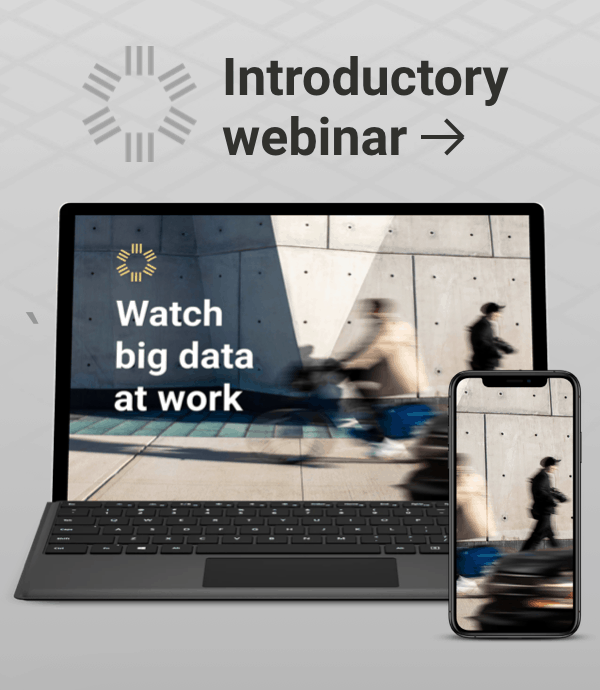
Big Data Meets Bike-Ped: Interview with Sean Co

Following the launch of the transportation industry’s first bicycle and pedestrian analytics in January, StreetLight Data welcomed seasoned planner and avid cyclist Sean Co to help drive industry adoption of our MULTI MODE analytics. Most recently at Strava, Sean has years of transportation planning experience at consulting firms and government agencies. We talked with Sean about his bike racing background, the power of Big Data bike and pedestrian metrics, and what fuels his passion for active transportation.
You have been deeply involved in cycling for a while now, how did that start?
That started when I had a paper route as a kid in Sacramento. I delivered newspapers on a bike, then I rode my bike to school. Mode shares for children who ride bikes to school has been dropping since the 1950s, so riding a bike to school was a little unusual. I competed in BMX a bit. My cousins through their Boy Scout troop mapped out a big bike ride from LA to San Diego, about 80 miles. I was only about 13, but I decided to go with them. Yeah, that’s a long trip, but it got me hooked.
After that we all got into racing as juniors with the U.S. Cycling Federation. I was doing multi-day stage races alongside future professional riders like George Hincapie, Freddie Rodriguez, and Lance Armstrong. Later, my cousin, Allen Lim, went on to start Skratch Labs. It’s a cycling nutrition company that works closely with pro cycling teams. Our interest in cycling helped my family find careers in a field we loved.
How did you transition into working with bike-ped data in transportation?
Since I’ve always been a bike rider, it was natural that my interest settled on bike-ped data. Being a cyclist helped me understand mobility at the ground level. I was also interested in the planning field, and studying how people move about in cities.
At U.C. Santa Cruz, I got my undergraduate degree in environmental studies – I was also president of the cycling team. As part of my studies I worked on a cool electric-vehicle project for the California Resources Board. The state wanted to improve air quality, mandating that a certain percentage of vehicles were zero-emission. We were trying to understand whether or not you could replace short car trips with limited-range EVs.
I did my graduate studies at U. C. Davis in transportation technology and policy. As part of that, I managed a big team working in Yosemite National Park to understand how people move around there – it was all modes including cars, buses, even people standing in line.
We found that people who regularly visit Yosemite park their cars, then walk or ride their bikes to get around the valley. With a few small changes the park could avoid big traffic jams. One result is the hybrid electric buses that currently move people around the park today.


How did you hear about StreetLight Data?
I was working as a transportation planning consultant, and saw a presentation from StreetLight about a project in Napa Valley. The planners used Big Data to pinpoint where visitors were coming from and going, and what was causing congestion. Napa residents were blaming increased traffic on tourists, but the analysis showed it was actually commuters working in Napa. I was impressed they were able to uncover that insight with computer data.
Then, when I was the general manager at Strava, I was deeply involved with licensing Strava’s bike-ped data to public agencies. I had previously served on the the bike/ped advisory committee at Caltrans for over 10 years, and had worked with the planners there. StreetLight’s name kept coming up, especially when they started working on capturing active transportation data.
What are some of the challenges in collecting accurate bike-ped data?
Bike-ped data has traditionally been a pretty raw product. You have to lay out infrared or pneumatic counters at limited locations to get an understanding of where people are moving not in cars. You download the data and put it on a map to understand the most popular routes, then see how that fits into your greater transportation picture. Planners usually have to hire a consultants to develop models to get all the meaningful information and write a report.
An additional challenges is that surveys don’t always capture accurate bike-ped data. Survey responders may not always think about their short trips, and short trips really matter to planners.
StreetLight has a dashboard that is easy for people to use. Nobody has ever collected bike-ped data in this comprehensive way. Having cities use this data makes it a completely different world for active transportation planning, with the ability to see the whole city at once.
How would you describe your personal mobility mission?
My goal is to make communities that are safer, more accessible, and more convenient to get around by walking or biking.
Part of why this is important to me has to do with public health and transportation. In the U.S. most of us do not get our thirty minutes of daily recommended exercise, that’s really hard to fit in with our busy lifestyles. But if you were to take an active mode of transportation, like walking to the bus or a bike ride, even fifteen minutes one way, you’d get that exercise without going to the gym. The health benefits of that are pretty huge.
But in order to do that, people need safe environments so they feel comfortable getting out of their cars and walking. Planners often don’t know where to put that infrastructure because they don’t even know if people are using it, and how they are using it. That’s what we can help with.